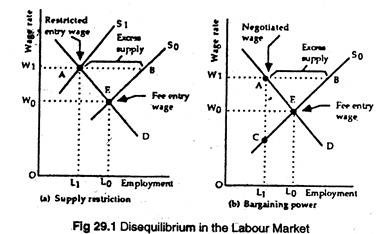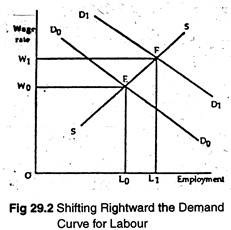The following points highlight the three main basic strategies of trade union to raise wages of its members. The strategies are: 1. Supply Restrictions 2. Bargaining Power 3. Increase in Demand.
Union Strategies:
A trade union can use three basic strategies to raise wages of its members. These strategies may now be discussed separately.
Strategy # 1. Supply Restrictions:
The easiest way of raising wages is to restrict the supply of competitive labour. Thus if a union can successfully reduce the supply of labour, higher wage rates will automatically result.
Different practices may be adopted by trade unions to limit the supply of labour to various occupations and jobs such as licensing requirements, long apprenticeship programmes, immigration barriers, high initiation fees, refusal to admit new members to the union, and prohibition of non union workers from holding jobs.
ADVERTISEMENTS:
In Fig. 1 (a) we analyze the impact of supply restrictions on wage rates. If the union is able to shift the supply curve of labour from S0 to S1, employers will agree to pay a higher wage, i.e., w1. Here we see that compared with a free-market equilibrium, the wage rate has gone up from w0 to w1, but employment has declined from L0 to L1.
In fact, there will be an excess supply of labour (AB) at the higher wage rate. The restrictive practices will prevent this excess supply from driving the wage rate down the original (competitive) level.
Because of the exclusionary practices, the union will be able to obtain higher wages for some of its members (i.e., L1 employees). Other members of the labour forces (i.e., L1 L0 workers) are willing to accept work even at the wage rate w0. But they will be forced to remain unemployed or seek employment opportunities elsewhere.
Strategy # 2. Bargaining Power:
The second way of raising wages is to exercise collective bargaining power. If trade unions have enough economic power a strike, by even a very small percentage of vital employees, can sometimes halt the flow of production.
ADVERTISEMENTS:
For example, a sudden work stoppage by airline mechanics can force major airlines to cancel their flights. Because the mechanics perform a strategic function, an airline cannot operate without their services even though they constitute only 10% of all airline employees.
If the union is able to set a standard wage rate above the competitive level, the impact on employment will be similar to a reduction in supply. As Fig. 1(b) shows, profit-maximizing employers will now hire fewer workers at a higher wage rate obtained by exercising their collective bargaining power.
The level of employment will fall below the competitive (free- entry) level from L0 to L1 as a result of the rise in wages. An excess supply of labour, AB, will exist, at least for some time. In such a situation non-wage methods of rationing jobs will become more important as more employees will seek the high-wage union jobs than employers will choose to hire.
Strategy # 3. Increase in Demand:
ADVERTISEMENTS:
The demand for labour service in a unionized industry is determined by factors outside the direct control of the union, such as the availability of substitute inputs and the demand for the product of the firm. However, if trade unions can impose greater discipline on others, labour productivity will rise.
In such a situation employers will voluntarily accept the demand for higher wages. As Fig. 2 shows, successful union actions to increase the demand for the services of union labourers result in both higher wages and an expansion in employment, but at the expense of consumers (who have now to pay higher price for the product of the unionized industry).

